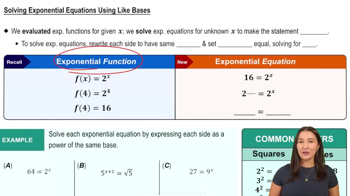Table of contents
- 0. Review of Algebra4h 16m
- 1. Equations & Inequalities3h 18m
- 2. Graphs of Equations43m
- 3. Functions2h 17m
- 4. Polynomial Functions1h 44m
- 5. Rational Functions1h 23m
- 6. Exponential & Logarithmic Functions2h 28m
- 7. Systems of Equations & Matrices4h 6m
- 8. Conic Sections2h 23m
- 9. Sequences, Series, & Induction1h 19m
- 10. Combinatorics & Probability1h 45m
6. Exponential & Logarithmic Functions
Solving Exponential and Logarithmic Equations
Problem 79a
Textbook Question
In Exercises 74–79, solve each logarithmic equation. log4 (2x+1) = log4 (x-3) + log4 (x+5)
 Verified step by step guidance
Verified step by step guidance1
Recognize that the equation involves logarithms with the same base, which allows us to use the properties of logarithms to simplify.
Use the property of logarithms that states \( \log_b A + \log_b B = \log_b (A \cdot B) \) to combine the right side: \( \log_4 (x-3) + \log_4 (x+5) = \log_4 ((x-3)(x+5)) \).
Set the expressions inside the logarithms equal to each other since the logarithms themselves are equal: \( 2x + 1 = (x-3)(x+5) \).
Expand the right side of the equation: \( (x-3)(x+5) = x^2 + 5x - 3x - 15 = x^2 + 2x - 15 \).
Rearrange the equation to form a quadratic equation: \( 2x + 1 = x^2 + 2x - 15 \) becomes \( 0 = x^2 + 2x - 15 - 2x - 1 \).
Recommended similar problem, with video answer:
 Verified Solution
Verified SolutionThis video solution was recommended by our tutors as helpful for the problem above
Video duration:
4mPlay a video:
Was this helpful?
Key Concepts
Here are the essential concepts you must grasp in order to answer the question correctly.
Logarithmic Properties
Understanding the properties of logarithms is essential for solving logarithmic equations. Key properties include the product rule, which states that log_b(mn) = log_b(m) + log_b(n), and the quotient rule, which states that log_b(m/n) = log_b(m) - log_b(n). These properties allow us to combine or separate logarithmic expressions, facilitating the solution process.
Recommended video:

Change of Base Property
Exponential Form
Logarithmic equations can often be solved by converting them into exponential form. For example, if log_b(a) = c, it can be rewritten as b^c = a. This transformation is crucial for isolating variables and simplifying the equation, making it easier to find the solution.
Recommended video:

Exponential Functions
Domain of Logarithmic Functions
When solving logarithmic equations, it is important to consider the domain restrictions. The argument of a logarithm must be positive; thus, any solutions must satisfy the conditions that 2x + 1 > 0, x - 3 > 0, and x + 5 > 0. This ensures that the solutions are valid within the context of the logarithmic function.
Recommended video:

Graphs of Logarithmic Functions

 4:46m
4:46mWatch next
Master Solving Exponential Equations Using Like Bases with a bite sized video explanation from Callie
Start learningRelated Videos
Related Practice













